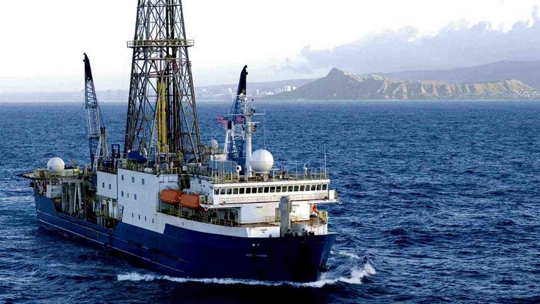Victoria scientists at the heart of world's biggest geoscience project
Victoria scientists at the heart of world's biggest geoscience project
Victoria University of Wellington is leading two major scientific drilling investigations in New Zealand and Antarctica as part of the world’s biggest geoscience project, the International Ocean Discovery Programme (IODP).

JOIDES Resolution research vessel. Photo credit: IODP
Starting in August 2017, the IODP’s research ship JOIDES Resolution will be based in New Zealand for a year to undertake five scientific expeditions.
Researchers from Victoria University will lead two of the expeditions, with participants likely to include scientists from GNS Science, NIWA and New Zealand universities, and experts from around the world.
Associate Professor Rupert Sutherland from Victoria’s School of Geography, Environment and Earth Sciences is the project lead on an expedition near the Lord Howe Rise west of New Zealand in the Tasman Sea.
“Our project seeks to understand how and why global plate motions have changed by collecting and analysing sediment layers that record formation of the Pacific Rim of Fire, north of New Zealand,” he says.
“We’re also going to try and solve the mystery of why the South Pacific was so hot fifty million years ago and why there were palm trees in Antarctica. Understanding this ancient greenhouse climate is of great interest to people involved with predicting our future climate.”
Rupert says it is exploration in a very poorly understood, but important region.
“It’s sure to result in scientific progress of global significance, and no doubt there will be some surprises too. We have been building a case for this expedition for five years, and now the international community is prepared to step up and bring one of the most advanced mobile scientific facilities in the world to our back yard.”
Dr Robert McKay from Victoria’s Antarctic Research Centre will lead the other expedition in Antarctica’s Ross Sea.
“We’re investigating past ice sheet behaviour in the Ross Sea,” he says. “By recovering geological data from beneath the seafloor off the Ross Ice Shelf, we want to understand how the West Antarctic ice sheets have behaved during the past twenty million years, and how changes in the ocean next to this massive ice sheet may have driven ice sheet collapses resulting in several metres of sea level rise.”
Professor Mike Wilson, Pro-Vice-Chancellor of the Faculties of Science, Engineering, Architecture and Design at Victoria University, says the announcement of the IODP expeditions is excellent and exciting news.
“This is a fantastic result for Victoria University as well as the New Zealand geoscience community. It represents not only significant investment, effort and collaboration, but a commitment to New Zealand scientists and engineers and the work that they are doing to improve our understanding of Earth.”
The remaining three expeditions, led by GNS Science and the University of Auckland, will investigate seafloor stability, how and why silent earthquakes occur, and the transport of fluids and metals in the Earth’s crust.
Contact:
Phone:
Email:
